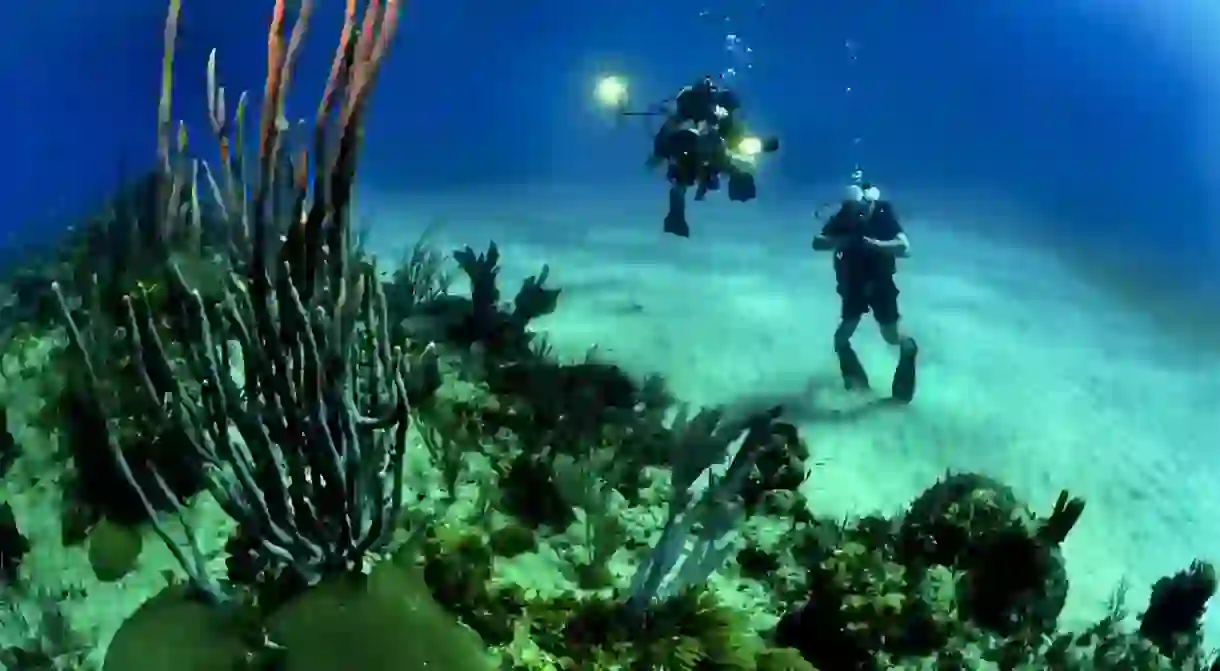A Guide to Scuba Diving in Cyprus

Are you looking for the perfect scuba diving destination? There are many ancient and modern wrecks to explore off the shores of Cyprus, as well as ancient artefacts and settlements. With the water temperature around 26°C (80°F), the island makes for a great diving spot – here’s everything you need to know.
How to get here
Cyprus, the Eastern Mediterranean island is the most populous in the Mediterranean and the third largest. To get here, take a flight to one of the two international airports, Paphos or Larnaca, or Ercan if heading to the Turkish side – North Cyprus. You can get direct flights from most regional airports in Europe, with the main hubs being Athens, Brussels, Amsterdam, London, and Manchester. Be aware that you can only fly into Ercan through Turkey. There is also a ferry service linking North Cyprus with Turkey.
Can you scuba dive in winter?
The simple answer is; yes you can! Temperatures during winter months (January to March) are 18°C (65°F) on average. This is warm by any standard, but you should consider wearing proper thermal protection, especially when doing long dives. Look for plenty of sunshine and blue skies when choosing winter diving days.

Spots to explore
Cyprus stands out when it comes to diving because of the many wrecks, as well as other underwater attractions, you can enjoy exploring.
The Wreck of the Zenobia
The Wreck of the Zenobia, a former Swedish RO-RO (roll-on, roll-off) ferry which sank in 1980 is the most popular wreck to explore. The entire length of the ferry is now colonized by local marine life, while the more than 100 trucks that were on board are still chained to the cargo deck, many now suspended from the wall – a truly striking sight to behold. In close proximity to this ruin is the Alexandria Wreck which has abundant fish life. There are two ways to go about viewing the wreck: you can dive, or opt for the glass-bottom boats that are also available for visitors.
The Copper Wreck
The Copper Wreck off the Akrotiri Peninsula is very near the surface. The wreckage is pretty broken up, but its nearness to the surface makes it ideal for first-time explorers.
Diana Wreck
Diana is the perfect wreck for underwater photographers. At 50 feet (15 metres), the waters are crystal clear. Diana attracts schools of fish all year round.
The Liberty Wreck
The Liberty Wreck in Protaras sits 27 metres (89 feet) below the water. Here you can see turtles, nudibranchs, triggerfish and rays, as well as solitary octopus and schools of jacks. This is an ideal spot for scuba diving training and underwater photography.

The HMS Cricket
The HMS Cricket was a gunboat from World War II. The wreck is located off Xylafagou. – be aware that you have to dive under the wreck to see the gun turrets, as it is upside down.
Lady Thetis
Sitting some 18 metres (59 feet) below the surface, Lady Thetis was a German recreational cruise boat. There are many areas for divers to explore the wreck, including the engine room, saloon and bridge area.
The Canyon
The Canyon, located south of Cape Greko under the cliffs, boasts fish such as stingrays, and has interesting rock formations. If this is interests you, try it out.
The Chapel Dive Site
The Chapel, located east of Ayia Napa, allows you to view sponges and scorpion fish along the walls of the underwater chapel. You could also do a night dive to spot octopus – this isn’t suitable for the average diver or beginners, as it caters for open water divers or their equivalent.

St George’s Island
Situated off the Akamas Marine Reserve, St George’s Island is an ideal diving spot for divers of all levels. It is located in Latchi, an area known for other dive sites including the St George’s Reef, highly recommended for beginners. In addition to the marine life in this location, a 35-metre (115-foot) old wall, ancient anchors, and caves are some of the attractions you can explore here.
The Amphorae Caves
The Amphorae Caves, located off Paphos, still has completely intact ancient pottery. Come prepared for an afternoon full of exciting things to see including beautiful coral and octopus.
Manajin Island
Manajin Island near Paphos has a rocky bottom where you can dive in for a magnificent experience. The rocks feature remains of ancient civilizations and these, plus the rock formations and the fish, make this a darling of underwater photographers.
Staying safe in a Cyprus scuba dive
Cyprus has a good safety record, but it is still your responsibility to take relevant safety measures. Here’s a quick run-through the safety precautions: always check your safety gear; never hold your breath while diving; avoid peer pressure; practise SAFE (safely ascend from every) dive; end dives with more than 50 bars of air supply; and ensure that you are fit to engage in a diving activity.
Things to do in Cyprus
Other than scuba diving, Cyprus has a great deal to offer. There are many ancient sites, among them Kourion, Ancient Salamis, Kolossi Castle and St. Hilarion Castle, while Larnaca is a popular resort with holidaymakers. A visit to the Troodos villages, nine of which are UNESCO World Heritage status, makes for a relaxing drive. Cyprus also has many beautiful white sandy beaches, and delicious local cuisine which has Balkan, Middle Eastern, and Southern European influences.













